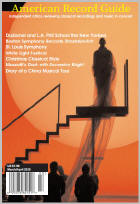Texte paru dans: / Appeared in: |
|
|
Outil de traduction ~ (Très approximatif) |
|
|
Reviewer: Peter
Loewen It comes as no surprise that church music in early 17th-Century Salzburg would reflect the same Italian influences one finds elsewhere in Catholic Europe. The Venetian concertato style, where voices combine with various string and wind instruments, could be heard as far away as Cracow. Recordings of music by Marcin Mielczewski (died c. 1651) make that abundantly clear. See for example the excellent recordings by Weser-Renaissance (CPO 777772; May/June 2015), Les Traversées Baroques (K617 226; Nov/Dec 2011), and especially Andrzej Kosen-diak’s recording of Motets, Canzonas, and Sunday Vespers (Accord 227; July/Aug 2017).
In Salzburg it was the Verona native Stefano Bernardi (1577-1637) who enriched the new Salzburg cathedral with the musical fashions of his homeland. Bernardi was lured to Austria in his mid-40s after serving as a church musician in Verona and Rome. By 1627 we find him in the employ of Prince-Archbishop Paris Lodron of Salzburg, where he appears to have composed ceremonial music in the grand style—masses, motets, and sacred concertos. Contemporary accounts attest to the drama of hearing musicians perform his multi-part music from various loges found around the interior of the cathedral. The Requiem Mass is performed in alternatim fashion, alternating chant and polyphony. Bernardi’s music indulges the warm sonority of voices and trombones, producing tall chords while passagework by the cornetts dances on top of them. In some respects, it replicates church decor—pillars supporting dramatic scenery painted overhead. Ad Te, Domine, Levavi Animam Meam is the perfect motet to show off the suavity of these voices and instruments. The alternation of solo voices, instruments, and chorus is mesmerizing. Voices borrow from contemporary ornamental practices to enhance their delicate counterpoint. And that practice continues into the two sinfonias (played by instruments alone). Violins, sackbuts, and cornetts are as expressive as the voices. In the words of Eva Neumayr, the head of music collections at the Archiv der Erzdiözese Salzburg: “Stefano Bernardi was without a doubt one of the greatest composers among an array of musicians who worked for and at the new Salzburg cathedral, and for whom one would wish more recognition”.
Texts and notes are in English.
| |
|
|
|
|
Cliquez l'un ou l'autre
bouton pour découvrir bien d'autres critiques de CD |
|




